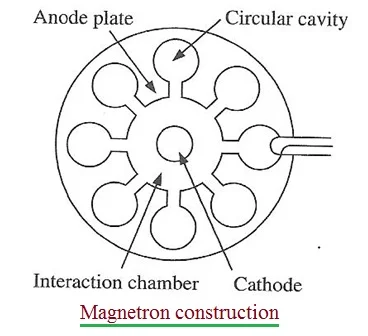Advantages of Magnetron | disadvantages of Magnetron
This page covers advantages and disadvantages of Magnetron. It mentions Magnetron advantages or benefits and Magnetron disadvantages or drawbacks. It provides links on various topics on Magnetron.
What is Magnetron?
Introduction:
It is one type of self excited high power microwave oscillator with multiple cavities.
It is different than linear beam tubes such as klystron and TWT.

Magnetrons are used for variety of applications as follows.
• CW oscillator in pulsed radar
• Voltage tunable magnetrons as sweep oscillators
• Fixed frequency oscillators in microwave ovens and heating appliances
It is a simple diode vacuum tube with multiple cavity resonators and powerful C-shaped permanent magnet. The magnet consists of cylindrical anode block which uses equally spaced resonant cavities in 8 to 20 numbers. These cavities are used to control output frequency. The diameter of cavity is equal to (λ/2) of desired operating frequency.
The figure-1 depicts construction diagram of magnetron tube.
Interaction chamber is used for interaction of E field and H field in order to
exert force on the electrons. Here magnet provides required magnetic field
parallel to the axis of the cathode.
Here output is taken using probe or loop coupled to either waveguide or coaxial cable.
Refer Magnetron basics >>.
Benefits or advantages of Magnetron
Following are the benefits or advantages of Magnetron:
➨It is used as high power output oscillator in pulsed and CW (Continuous Wave) mode.
➨Magnetron sputtering is high rate vacuum coating technique used for
depositing metals, alloys and compounds onto wide range of materials.
It has many advantages over other vacuum coating techniques such as
high deposition rates, ease of sputtering, high purity films,
high adhesion of films, ability to coat heat-sensitive substrates etc.
Drawbacks or disadvantages of Magnetron
Following are the disadvantages of Magnetron:
➨They are designed to operate in π-mode where phase difference between
adjacent resonators is 180 degrees. In order to have strong interaction between wave on anode and electron beam,
phase velocity of wave should be nearly equal to drift velocity (VΦ).
The oscillations for π-mode start at beam voltage, V0h = (2*π*f)/N * (b2 - a2)*Bo,
where V0h is called as Hartree voltage, f is operating frequency and
N is number of resonators. These are assumptions for successful operation of the magnetron which should be
taken are during the design otherwise it will not provide desired results.
➨Magnetrons are tunable where in output frequency of magnetron can be changed
by varying resonant frequency of the cavity. Ferrites and piezoelectric materials are used
to tune the magnetron device.
The tuning is practicable at moderate power level only.
It is difficult to tune magnetron at high power levels.
➨They do not have slow wave structure (i.e. phase velocity is less compare to speed of light) as used in
TWT and CFA.
Advantages and Disadvantages of other wireless technologies
What is Difference between
difference between OFDM and OFDMA
Difference between SC-FDMA and OFDM
Difference between SISO and MIMO
Difference between TDD and FDD
FDMA vs TDMA vs CDMA
FDM vs TDM
CDMA vs GSM
